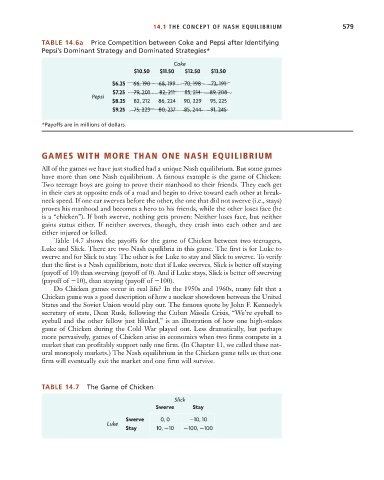Page 605 - Microeconomics, Fourth Edition
P. 605
c14gametheoryandstrategicbehavior.qxd 8/6/10 11:57 AM Page 579
14.1 THE CONCEPT OF NASH EQUILIBRIUM 579
TABLE 14.6a Price Competition between Coke and Pepsi after Identifying
Pepsi’s Dominant Strategy and Dominated Strategies*
Coke
$10.50 $11.50 $12.50 $13.50
$6.25 66, 190 68, 199 70, 198 73, 191
$7.25 79, 201 82, 211 85, 214 89, 208
Pepsi
$8.25 82, 212 86, 224 90, 229 95, 225
$9.25 75, 223 80, 237 85, 244 91, 245
*Payoffs are in millions of dollars.
GAMES WITH MORE THAN ONE NASH EQUILIBRIUM
All of the games we have just studied had a unique Nash equilibrium. But some games
have more than one Nash equilibrium. A famous example is the game of Chicken:
Two teenage boys are going to prove their manhood to their friends. They each get
in their cars at opposite ends of a road and begin to drive toward each other at break-
neck speed. If one car swerves before the other, the one that did not swerve (i.e., stays)
proves his manhood and becomes a hero to his friends, while the other loses face (he
is a “chicken”). If both swerve, nothing gets proven: Neither loses face, but neither
gains status either. If neither swerves, though, they crash into each other and are
either injured or killed.
Table 14.7 shows the payoffs for the game of Chicken between two teenagers,
Luke and Slick. There are two Nash equilibria in this game. The first is for Luke to
swerve and for Slick to stay. The other is for Luke to stay and Slick to swerve. To verify
that the first is a Nash equilibrium, note that if Luke swerves, Slick is better off staying
(payoff of 10) than swerving (payoff of 0). And if Luke stays, Slick is better off swerving
(payoff of 10), than staying (payoff of 100).
Do Chicken games occur in real life? In the 1950s and 1960s, many felt that a
Chicken game was a good description of how a nuclear showdown between the United
States and the Soviet Union would play out. The famous quote by John F. Kennedy’s
secretary of state, Dean Rusk, following the Cuban Missile Crisis, “We’re eyeball to
eyeball and the other fellow just blinked,” is an illustration of how one high-stakes
game of Chicken during the Cold War played out. Less dramatically, but perhaps
more pervasively, games of Chicken arise in economics when two firms compete in a
market that can profitably support only one firm. (In Chapter 11, we called these nat-
ural monopoly markets.) The Nash equilibrium in the Chicken game tells us that one
firm will eventually exit the market and one firm will survive.
TABLE 14.7 The Game of Chicken
Slick
Swerve Stay
Swerve 0, 0 10, 10
Luke
Stay 10, 10 100, 100

